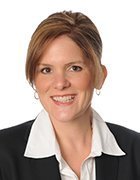ECM project ushers in BPM at Rehmann Financial
An enterprise content management project to eliminate paper and shore up compliance morphed into a business process management initiative.
When Amy Flourry talks about instituting change at her company, you can hear her enthusiasm.
 Amy Flourry
Amy Flourry
For Flourry, the senior operations manager at Rehmann Financial, a financial services company based in Lansing, Mich., an enterprise content management (ECM) project has been nothing short of organization-changing. What began as an effort to eliminate paper-based files and streamline compliance tasks ultimately gave way to a broader business process management (BPM) initiative. But it took change management tactics to shepherd the company to success.
In 2007-2008, Rehmann Financial and its parent firm had many disparate processes in place for storing and managing documents. The processes varied considerably among the company's 13 locations in multiple states. "Each silo had its own technology its own tools," Flourry recalled. "There wasn't any consistency or centralized data and each office functioned on its own."
Rehmann's paper-based processes also created a confusing, sprawling collection of physical files -- and sometimes a rainbow of colors to indicate different document types. Compliance audits were an inefficient mess in the face of differing conventions.
"In one office, the yellow file was correspondence, the purple file was new account paperwork, the green file was insurance," Flourry noted. "In another, they would use manila envelopes and you had to read the tabs. Deciphering all those different systems, pulling files -- let alone having someone pull the wrong file -- it would take a couple of days per office for all that back and forth. "
Conflicting processes created human error, manual tasks took time away from other work and cabinets of physical documents took up space. "It's kind of amazing when you look at how clunky we used to be," Flourry noted.
It's kind of amazing when you look at how clunky we used to be.
Amy Flourry,
senior operations manager, Rehmann Financial
Reining in chaos
As Flourry and other Rehmann employees began considering ECM software with the help of their value-added reseller (VAR), Cities Digital, they realized the far-flung document estate could become digitized, centralized, standardized and automated.
But Rehmann needed a system that would complement its business processes as well as integrate with the company's customer relationship management (CRM) system, Junxure . Existing manual practices needed to be modified and Flourry began training employees to work digitally within the CRM system before introducing ECM software. "We did a lot of, 'Go back and put it in the CRM. If it's not in the CRM and just written down, that's not enough.'"
Then Flourry began to develop a process for evaluating ECM systems. To identify requirements, Flourry assembled a committee, with key stakeholders from the adviser, compliance and administrative teams, to evaluate short-list candidates and select ECM software. "We created a chart and compared the candidates against our needs and nice-to-haves. We had discussion back and forth on likes and dislikes," she said.
Not only did the committee help choose the right ECM, it also helped with its change management strategy. "Now I had a group of advocates. So I could say, 'This team member helped pick this one, so you guys should try it.' Approaching it that way helped with some of the resistance."
Ultimately, the team settled on Laserfiche's ECM software, particularly because of its integration with existing applications.
Streamlining business process through ECM
Once Laserfiche was implemented, Flourry worked with the VAR to align Laserfiche workflows with the companies' compliance processes. With the ECM software, Rehmann Financial began scanning formerly paper-based documents, digitizing and automating workflows and standardizing document-naming and retention processes throughout the company. As a result, compliance audits could become proactive and ongoing.
Tasks that were previously manual -- and thus subject to error and delay -- began to take place automatically. Rehmann's experience with ECM introducing BPM is not uncommon. According to Alan Weintraub, a principal analyst at Forrester Research Inc. in Cambridge, Mass., "Three, four years ago, the primary driver [for ECM purchases] was compliance. Now the driver has moved to productivity and process improvement."
Laserfiche's Workflow Designer, for example, moves documents through each phase of the compliance process, from the scan stage to review and signoff. The application automatically sends the document to the appropriate party and prompts him or her to take action. It "takes the question out" of employees' hands and automates a process that could sit in paper files, languishing on someone's desk.
"Now the compliance team can do everything behind the scenes," Flourry said. "They don't have to spend two days on-site pulling files and reviewing paperwork. They are doing it remotely and they are doing it all the time."
Integration between the Laserfiche ECM and the Junxure CRM also introduced important business process efficiencies. Tight integration between the two enables data to populate directly from one to the other. A mail merge that is initiated in Junxure, for example, can generate a master copy in a central correspondence folder, as well as shortcuts for each individual financial services client and filing for each letter. "That is hours of work that now happens instantaneously," Flourry noted.
Now Rehmann Financial is delving further into BPM by automating data entry and new account processing. Laserfiche enables employees to scan documents and auto-populate the ECM software with information about the document, the client name and company, and other information. Quick fields "will read through the document and populate those fields based on what is already in the document.," Flourry said. "Anytime you reduce keystrokes, you reduce error."
Change management at core of ECM project success
One lesson that Flourry has learned since launching the new ECM initiative is that corralling content also requires corralling people.
If the processes are different in different places, noted Doug Miles, the director of market intelligence at the Association for Image and Information Management based in Silver Spring, Md., "you have a change management project on your hands."
For more on ECM
The benefits of no-IT technologies
ECM adoption remains patchy
ECM maturity: The jury's still out
So IT managers should take note: Part of implementing software designed to change business process requires managing organizational change. Flourry anticipated the need for change management from the get-go. "We knew people would be hesitant or fly under the radar and not use [the ECM system] because it is confusing," Flourry recalled. "But we tried to prepare going into it."
Part of change management involved building the stakeholder team, then developing trust and buy-in. Another critical piece was making the transition process from paper-based to digital systems a true team effort.
"We set up challenges to scan in the legacy items over time. We told people, 'You can wear jeans, and we're going to order a pizza and we'll commit to scanning files for three hours.' The motto has been 'Eat the elephant one bite at a time.' We're not 100% there, but most offices have been able to get rid of their paper and those huge beast filing cabinets."
This bite-sized approach to change management has been critical. Flourry noted that many companies want to implement ECM and try to swallow the ocean instead of taking an incremental approach. "Take it one step at a time so that it doesn't become overwhelming."
Finally, having a VAR onboard to troubleshoot and customize eased the pain of the transition and gave Flourry's team more flexibility. "Over time, more people loved [the ECM software] than wanted to fight it," Flourry said. "Now everyone is on board with it."







